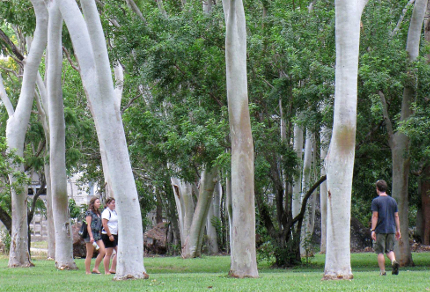In mid-morning, I cycled to James Cook University, with heat radiating off the bitumen path in the Ross River Parkway and the river itself throwing me rich, wet smells. At the uni, I wandered the campus grounds, enjoying the butterflies, including huge blue and black Ulysses swallowtails, that flitted within the small patch of rainforest edging a sandy-bottomed creek that flows through the campus.

Students and Poplar Gums at JCU (© Magi Nams)
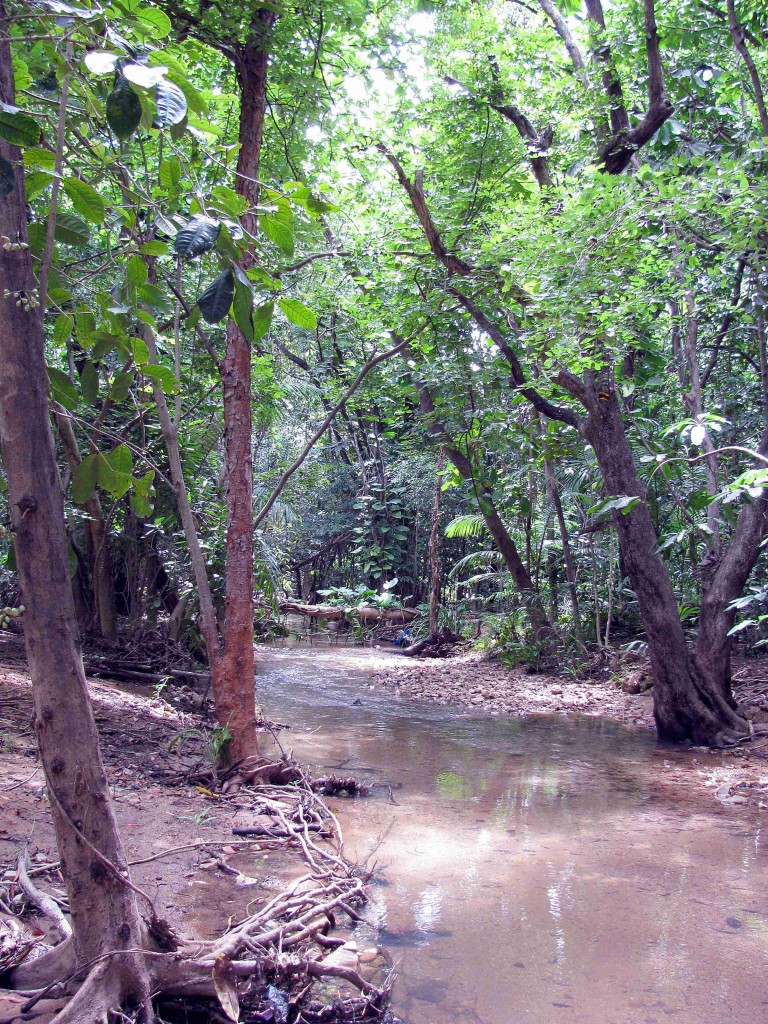
Rainforest patch at JCU (© Magi Nams)
The morning seemed a quiet one for birds, although brush-turkeys wandered through the woods, scratching up leaf litter and pecking at food items in the soil I couldn’t see, one of the turkeys an immature bird noticeably smaller than the adults and dressed out in a duller plumage. A laughing kookaburra perched silent and watchful on a tree branch, and two bush stone-curlews stood in their peculiar frozen, head-thrust-forward stance in the shade of shrubs. Once, the stone-curlews released wailing, broken calls that spilled across the open green bordered by the creek, the library and the School of Marine and Tropical Biology.
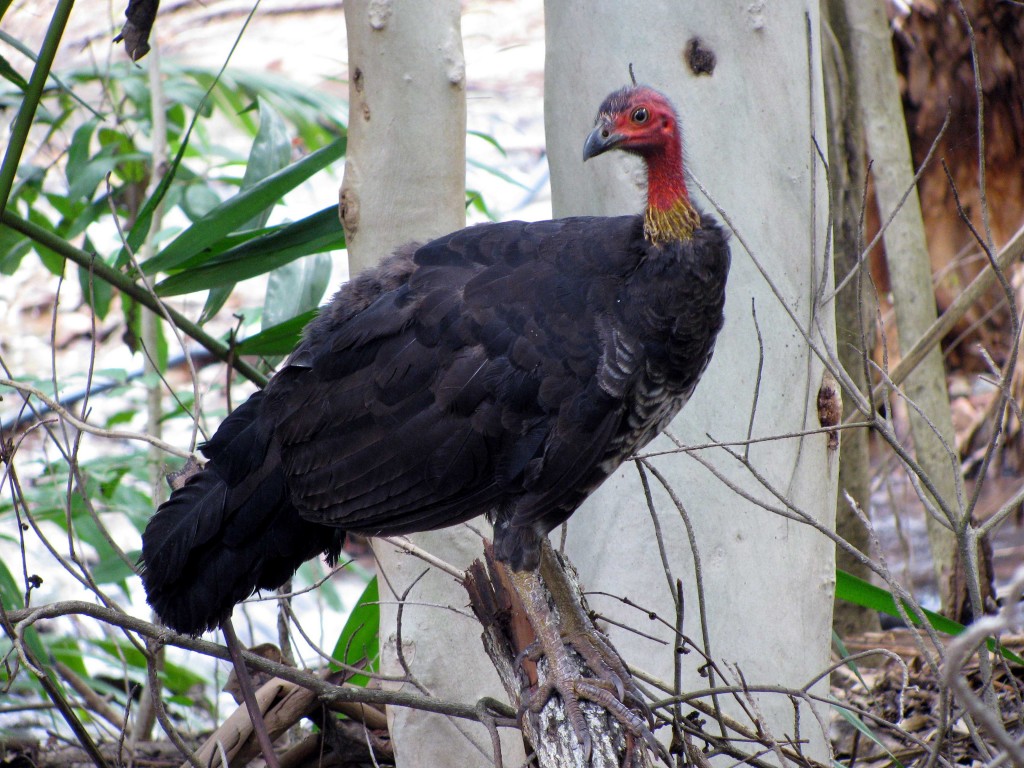
Australian Brush-turkey at JCU (© Magi Nams)
Within the rainforest, a young, scruffy-looking spangled drongo hissed out begging calls for food, and two helmeted friarbirds swept in long, gliding curves into a fig tree. Rainbow lorikeets, far more subdued that I usually see them, carried out muttering, low-level conversations while feeding on the nectar of umbrella tree blossoms in the same tree in which an immature dusky honeyeater also fed on the flowers’ nectar. Seeing the two species of nectar feeders foraging right in front of my eyes made me wonder how important tree and shrub nectar is as a food for Australian animals – a topic I’ll explore in a future post.
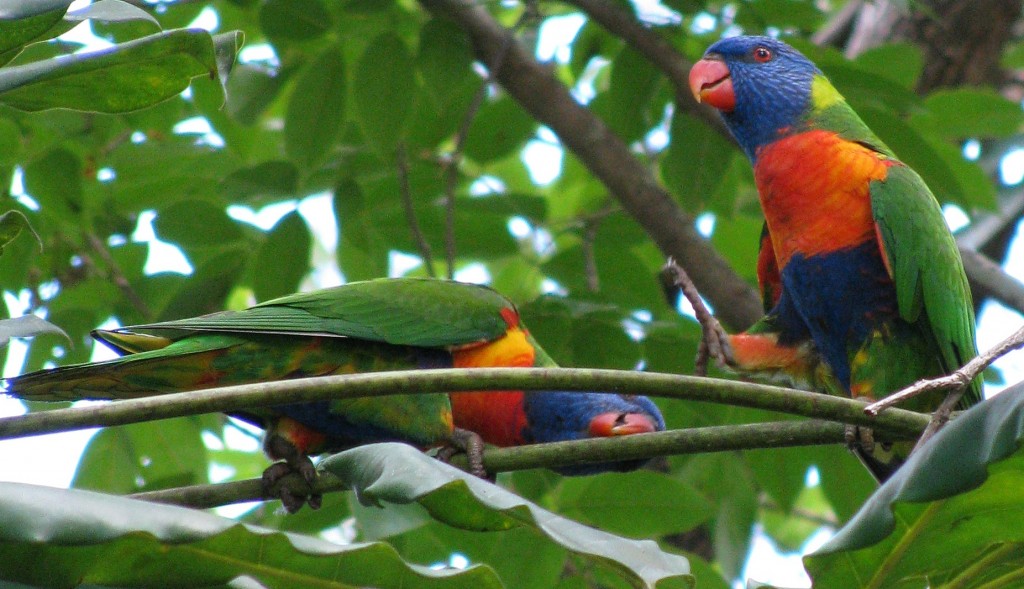
Rainbow Lorikeets at JCU (© Magi Nams)
Previously, I had visited JCU during the summer break, when human bodies wandering the campus were few and far between. Today, however, students thronged from building to building, each on his or her personal schedule of classes and free time to hang out on a bench or at a picnic table, or to catch a cup of espresso at the campus café called Bambini’s tucked against the edge of the rainforest.
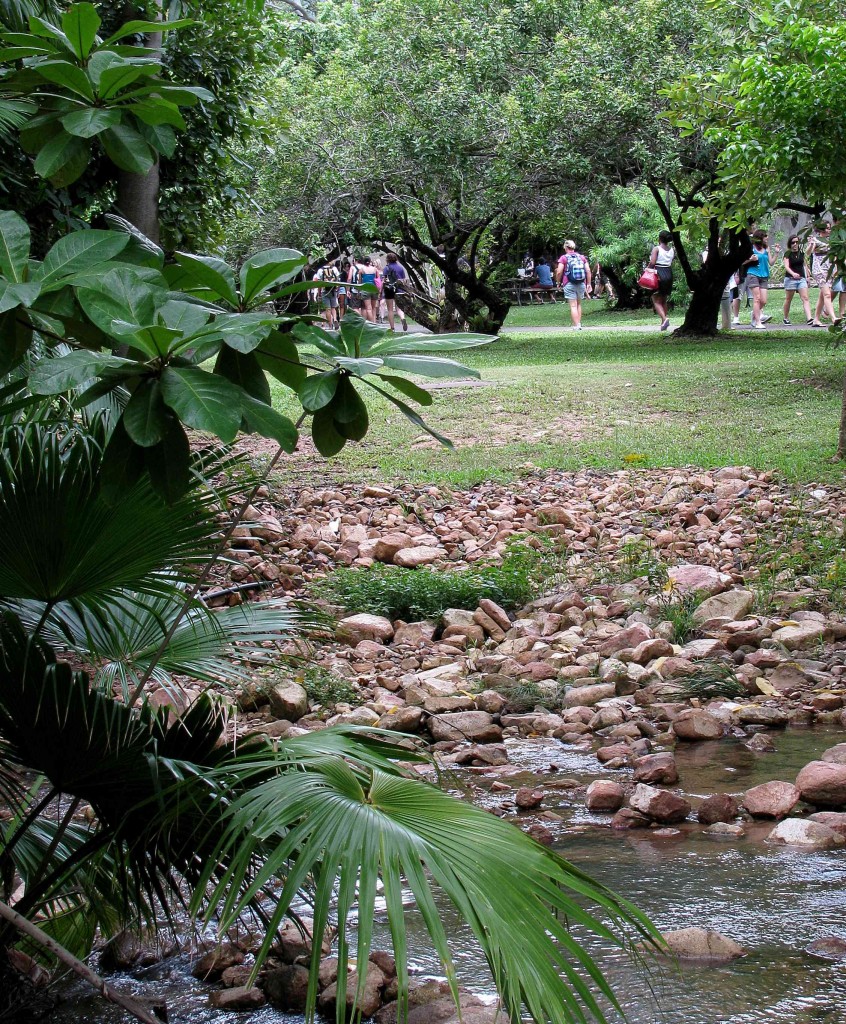
Students near Library at JCU (© Magi Nams)
I joined Vilis for lunch in the tea room of the School of Marine and Tropical Biology. Chris Johnson stopped by to say hi and, when the conversation again drifted to bowerbirds, told us an anecdote about how he had used JCU’s great bowerbirds to assist him in teaching students about radio telemetry. He painted radio transmitters green and set them as decorations at various bowers on campus. The students’ task was to find the transmitters, and in doing so, they and he saw where the techno decorations ended up, and thus, who had robbed who in the competition among male great bowerbirds.
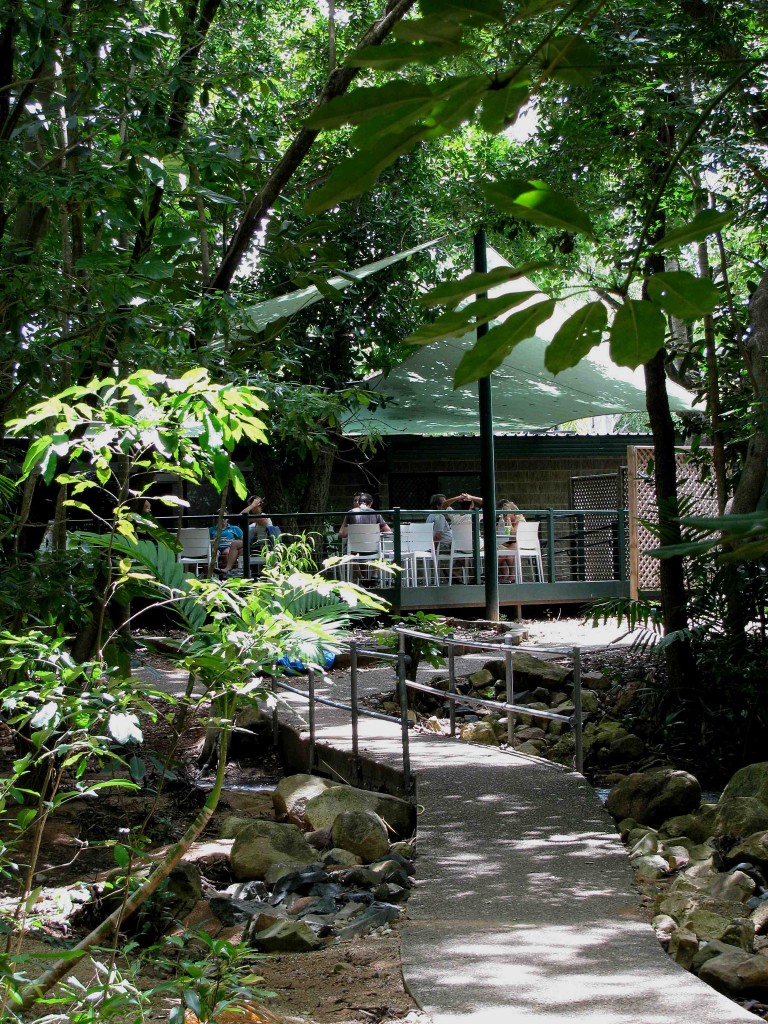
Bambini’s Cafe beside the Rainforest (© Magi Nams)
I spent the afternoon lazily exploring more of the campus and realized that this university truly reflects the climate of North Queensland. Clusters of tables and chairs near vending machines, which in Canada would be within an enclosed structure, at JCU were sheltered from above, but otherwise exposed to ambient temperatures. A complex of lecture theatres shared a covered hall but no surrounding, insulating exterior walls. The doors of the theatres opened directly into the hallway, which shared the same air as the great outdoors. It all seemed so casual, so easy, an atmosphere reinforced by the nearly ubiquitous flip flops and shorts worn by students.
Today, however, was sunny. When Vilis and I left the tea room after lunch, he paused on a covered, open walkway between parts of the Marine and Tropical Biology building to tell me that he sometimes goes there to warm up, because the air conditioning keeps the school so cold he wears a sweater in his office. He also mentioned that, on days when the wet has been calling the shots, from that walkway he’s observed students hesitating in the shelter of roof overhangs before dashing out into pouring rain.

Student on Bridge over Rainforest Stream (© Magi Nams)
I spent hours in the Eddie Koiki Mabo Library, surrounded by multi-racial students of varying ages, most undergraduates, I guessed, but some likely graduate students. I skimmed through a book called Bowerbirds: Nature, Art, History and learned that bowerbirds live only in Australia and New Guinea, and that while males of several species construct avenue bowers, others construct immense maypole bowers, double maypole bowers, or roofed maypole bowers that resemble conical huts with an open wall.1
The photographs that completely enchanted me were those of the male satin bowerbird with his glossy, blue-black plumage and predilection for blue and yellow decorations at his avenue bower. While chatting during lunch, Chris had also mentioned a researcher who found the bowers of satin bowerbirds by attaching blue streamers to radio transmitters and tossing them out the window while he drove along. Since blue items for decorations are fairly rare in nature, the satin bowerbirds snatched up the radio transmitters with their long, blue tails and carried them back to their bowers, conveniently identifying the bowers’ locations in the process.
I may also have found the answer to a question I posed to myself in a previous post, namely What’s the top priority for wildlife management in Australia? I now think, based on information I read in Chris Johnson’s book, Australia’s Mammal Extinctions: A 50 000 year history, that it’s saving endangered mammals from extinction. Australia has an astonishing rate of mammal extinctions, having accounted for nearly half of the world’s mammalian extinctions during the past 200 years.2 This is another topic I’ll explore in more detail in a future post. I ran out of time to read more, and instead rushed back to the Marine and Tropical Sciences building to meet Vilis, who at 4 p.m. presented a seminar about olfactory (smell) search images in skunks to the Townsville School of Marine and Tropical Biology and, via video conferencing, to the Cairns campus of JCU as well. Then we cycled home, the university’s stimulating fragrance of mental challenge wafting along with us.
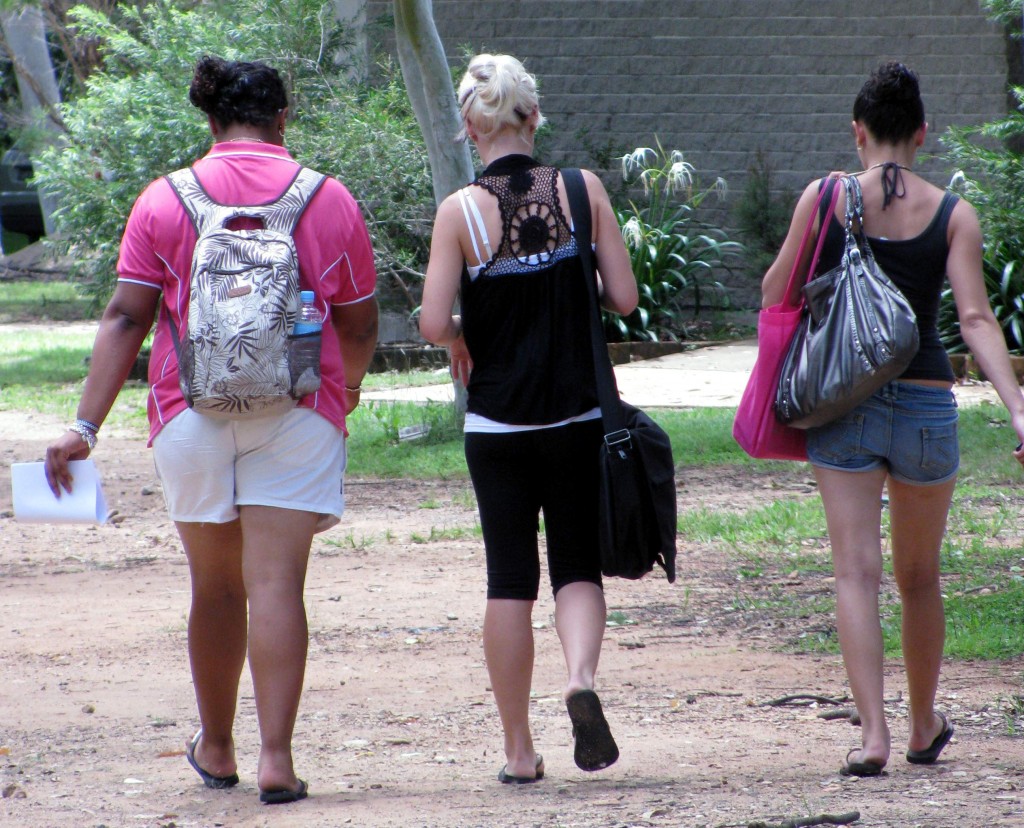
JCU Students (© Magi Nams)
References:
1. Clifford B. Frith and Dawn. W. Frith. Bowerbirds: Nature, Art, History. 2008. Frith&Frith, Malanda, Queensland. pp. 9-14, 25, 31.
2. Chris Johnson. Australia’s Mammal Extinctions: A 50 000 year history. 2006. Cambridge University Press, Cambridge. Preface, p. vii.

